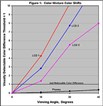Photometry, Colorimetry And Viewing Angle Artifacts Found In High-End LCD HDTVs

Insight Media (www.insightmedia.info), in cooperation with DisplayMate Technologies, (www.displaymate.com ) has completed a wide variety of benchmark performance tests on a series of top-of-the line HD LCDs from the top brands. The results of this testing are available in the Performance Benchmark Report on LCD HDTVs.
While on-axis performance is quite good in these TVs, at off angles the color shifts are noticeable and potentially a serious problem. Worse, TVs with native extended color gamuts produced significantly larger color errors at off angles.
In the testing, 9 LCD HDTVs, 1 PDP TV and 1 CRT TV were evaluated. All were calibrated to produce image quality as close as possible to an HDTV studio monitor. A number of test patterns and images were then developed to characterize and evaluate each display. The TVs were set up side-by-side and fed identical digital signals to aid in comparison between each TV. Screen shots and spectroradiometer measurements captured the results.
We found that the Plasma displays deliver very close to true (full) 180 degree (±90 degree) viewing angles, the same as traditional CRT monitors. There is very little change in brightness, contrast, hue, or color saturation over the entire 180 degree viewing area.
On the other hand, all LCDs show large viewing angle artifacts. Even when viewers are seated close together side-by-side, each person will see a different picture with noticeably different coloration in both hue and saturation, as well as variations in contrast and black level. There are clearly noticeable differences at ±15 degrees and large differences at ±30 degrees.
This effect is due to the fact that for bright LCD sub-pixels the brightness decreases with viewing angle and for dim sub-pixels the brightness increases with viewing angle, leading to contrast reversal. Since this occurs independently for each of the red, green, and blue sub-pixels, it leads to a rather complex behavior of brightness and color variation with viewing angle. Color mixtures show the greatest variations, but displays are engineered to balance out the effect for whites and grays.
LCDs with extended color gamuts show additional and much stronger viewing angle artifacts than LCDs with a standard HDTV color gamut. This is because the standard HDTV primary colors must be generated as color mixtures of the extended gamut primary colors, and those color mixtures then vary with viewing angle just like the other colors. As a result a much larger fraction of the HDTV color gamut shows a strong variation with angle.
In addition, the report discusses the measurements of contrast, luminance, black levels, display transfer functions, gamma, the effects of dynamic backlights and LED backlights on image quality and performance metrics, motion blur and chromaticity data.
Details of these measurements, comparisons and analysis are available now from Insight Media for $299. The report details all setups, procedures, results and conclusions, including photographic illustrations of the various artifacts.
This report will be of interest to LCD panel makers, TV makers, competitive technology TV makers, and component suppliers.
"Many in the industry will find the off axis results not unexpected, but the level of color inaccuracy and the enhanced effect with wide color gamut displays, was a surprise to us and to everyone that came by to observe the testing, as it will be to the entire display industry," noted DisplayMate President, Dr. Raymond Soneira. "Understanding these effects can help system integrators and OEMs select the best LCD for their applications, and LCD manufacturers to do a better job with the next generation products."
About Insight Media
Insight Media (www.insightmedia.info ) is a leading publishing and consulting firm focused on the display industry. With its core team of world-class display experts, Insight Media tracks the technology, components, products, markets, applications, manufacturing and business aspects of consumer and professional display markets. The company publishes daily and monthly news and analysis as well as in-depth annual technology/market reports. It also hosts industry conferences, provides strategic and tactical consulting services and offers industry education via webinars and on-site seminars.
SOURCE: Insight Media
